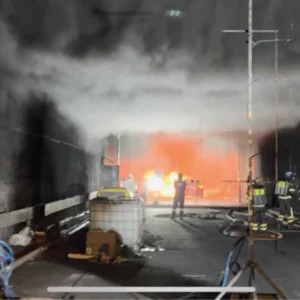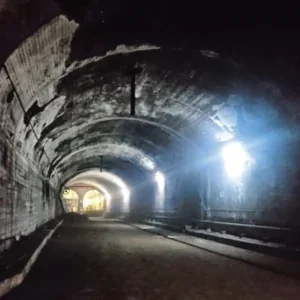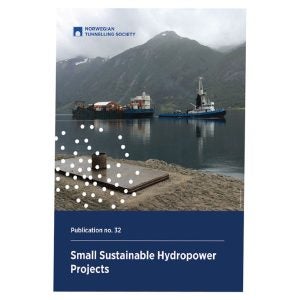Salt corrosion can have serious consequences: crumbling concrete, accidents, and costly, lengthy renovations accompanied by congested traffic. Materials experts from Wacker have developed water-repellent special silanes, which protect concrete for years by preventing salts from penetrating into the concrete. Highway bridges in Bavaria, Germany, are routinely protected in this way already. Recently the roof of the Gotthard tunnel in Switzerland was also treated with special silanes.
Despite presenting a fabulous panoramic backdrop, the Alps are a real nuisance to traffic. In 2008 about 1.27 million trucks crossed over the four major Alpine passes in Switzerland alone. The burgeoning stream of traffic also flows underground through the more than 50 road tunnels through the Swiss Alps. Closing off just one of these extremely busy arteries, such as the Gotthard Tunnel, can be likened to an obstruction in a blood vessel, and the results can also be devastating with a serious risk of congestion.
The Gotthard tunnel is at the heart of the most direct road link between the North Sea and southern Italy. The flow of cars, buses and trucks under the legendary massif of gneiss and granite rarely comes to a standstill. Vehicles have been passing through the 16.9km-long tunnel since 1980, carrying holidaymakers, autoparts and electrical goods from north to south, and hauling tomatoes, machinery and textiles back from Italy to Germany, the Netherlands and Denmark. Every year, some 750 000 trucks trundle through the the depths of the Gotthard massif.
Salt on concrete
Every winter, these vehicles unintentionally transport additional material into the tunnel – salt water. The spray thrown up from the wet road surface by millions of tyres splashes directly onto the roof and walls of the tunnel. The deposited salt attracts more water, and the constantly damp conditions favour its slow penetration into the concrete. Over the years, the porosity of the concrete enables the chlorides to eat their way further and further inside. Then, once salt-laden moisture makes contact with the steel bars, or reinforcing cage, an ominous corrosion process is set into motion.
Usually the pH level of concrete is high enough to protect the steel, but it is powerless against salt chlorides, which cause the pH to fall and the protection to disappear. Because corroded steel has more volume it presses against the concrete from the inside and forces parts of the concrete to eventually break off. This can have serious consequences.
Since 2002, therefore, a special ‘Suspended Ceiling’ working group at the Swiss Federal Roads Authority (ASTRA) has been monitoring the structural condition of the Gotthard Tunnel, initiating repairs as needed. In 2006 it instigated rehabilitation work of the entrances, treating some 250m of the tunnel with a water- repellent. The concrete was impregnated with an active ingredient that lines its pores and renders them water repellent while retaining their vapour permeability. The concrete thus continues to ‘breathe’.
Measurements and on-line monitoring of corrosion currents showed that these steps greatly reduced the extent of corrosion. It was therefore decided to impregnate a further 750m of the tunnel with water repellent. Although a complex coating already protects the concrete structure, the tunnel roof needed to be repaired.
Structural or rehabilitation work of this kind requires extensive preparation and safety precautions, and so both are very costly and almost impossible to do so long as the tunnel remains open.
This is especially true of the busy Gotthard Tunnel, which can only be closed for brief periods because of the huge volume of traffic. Comprehensive measures, such as the application of an epoxy resin coating, are nearly impossible to carry out in such a short period of time. For this reason, the tunnel operators opted for deep impregnation and arranged for more than 7000 square metres of ceiling to be impregnated with silane in a single night to protect the concrete in the ceiling against the ingress of salt water.
“It has been shown that highly alkylated silanes, such as Silres BS Creme C, are the best products for such tasks,” says Dr. Johannes Ihringer, a Wacker materials expert. “Unlike conventional liquid products, they can be applied in the right thickness at one go. The substrate’s porosity determines how quickly the active ingredient can penetrate.” This was a key argument for the decision to use the Wacker product in the Gotthard Tunnel. After all, time was of the essence.
All systems stopped at precisely 20:00, 21 September 2009, and the tunnel was closed. Work started simultaneously on the northern and southern entrances. The workers at both ends of the tunnel had until 04:30 to finish the job, because the traffic could not be held up any longer than that.
Race against time
With all the proverbial precision of a Swiss watch, the repair gangs swung into action. As soon as the last truck has passed, some two dozen workers dressed in white clothing and high-visibility jackets begin ‘Operation Gotthard’ at the southern entrance. First, painters and concrete repair specialists covered the entire road surface with sheeting. Arnold Wyssen, a master painter, specially commissioned a device for unrolling the sheeting for the southern side: “We have to cover 7000 square metres of road in three hours,” he says.
Afterwards, a Novapplica robot sprayed water repellent onto the tunnel roof. “The spray mist containing the silane cannot be allowed to get onto the road surface because that would make it as slippery as soap and cause drivers serious problems,” says Ralph Minery, the responsible sales manager from the construction chemicals business team at Wacker, Switzerland. It was Minery’s job to monitor the work’s progress throughout the night.
After everything was covered, the spray gun could get to work: twice the automatic sprayer traversed the 750m of tunnel, its 12 nozzles covering the roof with about 500g of material per square metre. After around five hours of loud hissing, the job was done. The workers from Novapplica had sprayed around 3.5t of material onto the ceiling.
The tunnel ventilation system was run at full speed to dry the roof, not stopping until dripping has ceased. Then the workers quickly remove the sheeting from the road and clean up the site. At 04:04 the construction gang left the tunnel, some 25 minutes ahead of schedule.
At precisely 05:00 the column of trucks once again moved through the heart of the mountain. “It was a risky undertaking, and we all knew we had to work at full power. Never before did a project like this have to be done in such a short time,” said Paolo Gattulli, branch manager of SikaLavori of Cadenazzo, Switzerland. This company, which was commissioned by ASTRA to do the work on the south portal, has been using silane active ingredients from Wacker for many years.
Prior to applying the water repellent, the SikaLavori experts had hosed down the roof with a high-pressure spray, and then hammered it by hand to sound out defects. Any that were found were cleaned out and repaired with special mortar. Only then could the waterproofing begin. Everyone knew the stakes were high – just one night had been allocated for the job, and any overrun would have cost tens of thousands of Swiss francs.
At the northern entrance Mapei performed the waterproofing. Its Swiss sales manager, Martin Schneider, also opted for Silres BS Creme C. “Because it is a paste, you can apply it much more thickly to every square metre. The cream sticks to the surface better, and that enables more of it to penetrate into the concrete,” he said.
To do the work in such a narrow time span would ‘not have been possible with any other material,’ said Schneider, who has been working for over 20 years in construction chemicals and collaborating for some 15 years with Minery.
“The silane cream has a long contact time and is designed to ensure maximum penetration of the concrete by the active ingredient. That way it offers optimal protection against water absorption and damage by road salt,” Minery explained. The depth to which the waterproofing agent penetrated the concrete was then examined by materials experts, who took drill cores when the work in the tunnel was completed.
“The goal of deep impregnation with our silane active ingredients is to penetrate to a depth of about 6mm, to provide a water- repellent lining within the concrete pores and to keep out salt water,” Dr. Johannes Ihringer explained. The high viscosity of the WACKER silane active ingredients ensures that they are not washed away again by water splashes and that they provide long- lasting protection.
“Conventional repairs to concrete structures, such as tunnels and bridges, can cost ten times as much as preventive measures such as hydrophobic impregnation. With this innovative technology, it’s possible to prevent the need for repairs – and so avoid high costs and consumption of energy and resources,” adds Ihringer.
Paolo Gattulli, SikaLavori, is confident of winning further deep-impregnation contracts in the future – after all, there is no shortage of tunnels in Switzerland. “Salt water will always be the arch-enemy of reinforced concrete. And the concrete needs to be given lasting protection,” said Gattulli. Speciality silanes from Wacker are clearly just as effective in tunnels as they are on highway bridges.
Spraying the ceiling of the Gotthard Tunnel with Wacker’s Silres BS Creme C to impregnate the concrete against moisture and salt With the tunnel completely closed to traffic last September, a special spray rig applies the impregnation silane






